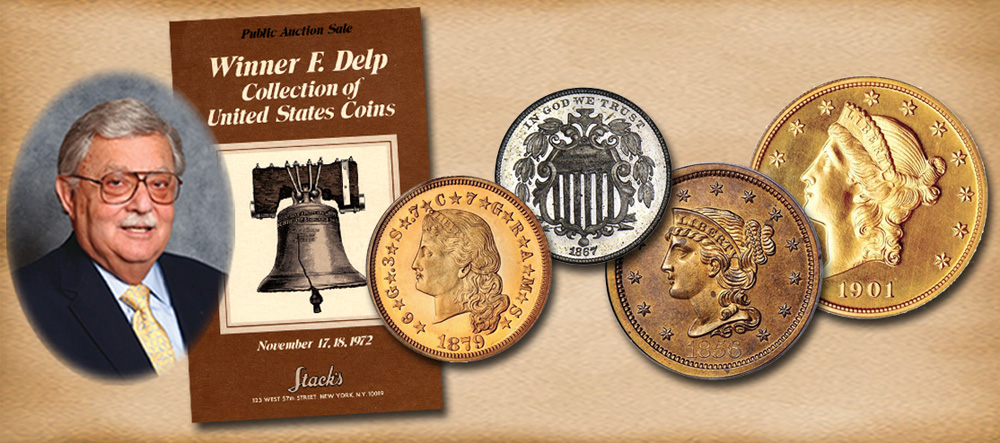
One recent weekend I was reviewing a group of Stack’s public auction catalogs from the early 1970s. I came across the name, Winner F. Delp — Stack’s conducted the sale of his collection in November 1972. Winner was a personal friend of the Stack family and I had the privilege of helping him build his noteworthy collection. He started collecting just before in went into service in World War II in 1942 and returned to numismatics upon his return home in 1947.
Mr. Delp loved well struck specimens, lovely iridescent toning and very attractive examples. How was he able to acquire so many choice and gem examples? It is a matter of timing and history. Many early collections were started in the 1920s and suddenly stopped being developed during the four years of World War II. Major collectors were drafted into service and were busy fighting a war; they had no time for collecting. However, there were old timers from the 1920s through the early 1940s who unfortunately passed away or lost interest. For this reason, collectors of the period had an unusual selection to choose from, and they of course collected the best they could find. The dealers of the period had huge inventories acquired during the 1920s through the end of the War, increasing the choices for collectors.
Some of the great pedigree names we know today came from the inventories assembled and accumulated during this period. For a dealer to have a dozen or even a roll or two of a given date on hand gave the collector a wide choice. So in collections formed from the 1940s to the mid 1970s one could find outstanding pieces, sometimes in abundance.
As I read the Delp catalog, which was a great collection for the 1970s and an outstanding collection in today’s terms, the list of prior owners was amazing. To give you an idea of the pedigrees found in this one collection the pedigrees included: the Randall Hoard, T.K. Harvin, John J. Pittman, Sam Wolfson, Grant Pierce, Charles Jay, Massachusetts Historical Society, Fairbanks, Woodin, F.C.C. Boyd, King Farouk, R.L. Miles , Jr., Maurice Bauman, Calvin Emmons, Alto, Gaston DiBello, Jerome Kern, George Walton, James Dines, and many more. These names became legendary after their collections were sold, and are repeated with pride in the pedigrees listed in many outstanding collections being offered today.
That’s is how the value of pedigree grows. Old name collections of yesteryear, known for the quality of the items, become well known as they are noted in the catalogs later offering the pieces for sale. As collections were sold and the coins moved to later collections, the pedigrees are expanded to reflect the collectors who have appreciated the pieces in the past.
If you are a student and understand the value of pedigree, you appreciate the ownership of a "known coin of the past" and cherish it because it did survive. That was the approach of Winner F. Delp — to gather together specimens that were cherished by others before him and add them to his. He did what every noteworthy collector did: he found a coin, examined it, studied it, developed a liking for it, and with pride added it to his collection.
It might have been easier in the mid 20th century to find such examples but the prize is always worth the chase. Today, it is harder to accomplish what earlier collectors were able to do in the mid 20th century, but the reward for finding and owning these pedigreed coins is the pride of possession!
Over eight decades Stack’s and Stack’s Bowers have dedicated themselves to working with the collector, learning what his goals are, helping him find and acquire the famous “coins of the past” and form an outstanding collection. Often we are then honored and privileged to present the collections formed in a specialized catalog to permanently commemorate the endeavors of the collector.





